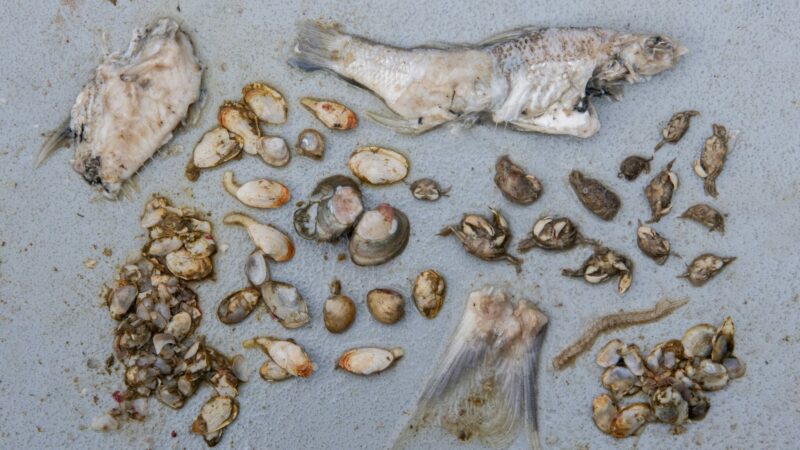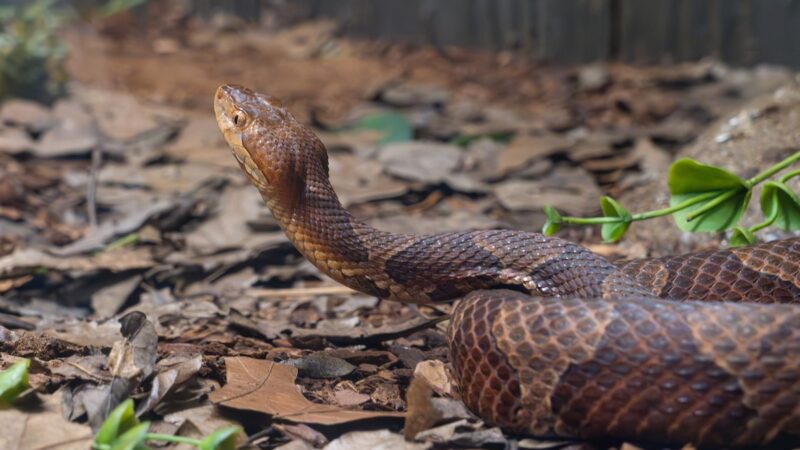Where Are All the Ducks?
Last year waterfowlers across the country commiserated about one of their worst duck seasons ever. The ducks, they said, just never showed up. Or when birds did come through their areas, they were in smaller groups rather than the historically massive flocks.
That’s why many waterfowlers were stunned when the U.S. Fish and Wildlife Service finally published its annual Waterfowl Population Report on Aug. 20, which seemingly highlighted good news. Mallard numbers are up from 2023, the most breeding ducks were counted since 2015, and duck populations overall are down just four percent from the long-term 70-year average.
Published on the same day, the USFWS Hunter Activity and Harvest report found that the U.S. actually added duck hunters to our ranks and killed millions more ducks than the year before — supposedly in a year when veteran waterfowlers were just scraping by.
So what’s actually going on? Are duck hunters just whining over a bad season? Or is the USFWS orchestrating some kind of cover up of bird declines so duck hunters keep buying licenses to fund their agency? As it turns out, neither.
In addition to speaking with veteran duck hunters for this story, I interviewed six waterfowl biologists — all of whom are duck hunters, too. Everyone agrees on a few key issues: Duck numbers are down. The loss of nesting habitat in Canada and elsewhere is almost certainly the primary driving force. And duck hunting just isn’t like it used to be.
Where opinions begin to diverge are around what the numbers in all these reports currently tells us, and what we should do to keep ducks numbers — and duck hunting — healthy.
What the Duck Hunters Are Saying
Now in his mid 60s, Lee Kjos has been visiting Canada to hunt and photograph ducks since he was a teenager. From eastern Manitoba to Alberta and all over Saskatchewan, he says wetlands and grass have vanished, and the ducks have disappeared with it.
“We’ve lost that habitat at an alarming rate,” says Kjos, who lives in Minnesota and still travels all over for duck season. “I used to go through areas that looked like Swiss cheese. Little potholes everywhere, and I mean hundreds of them in an area. And they’re gone.”
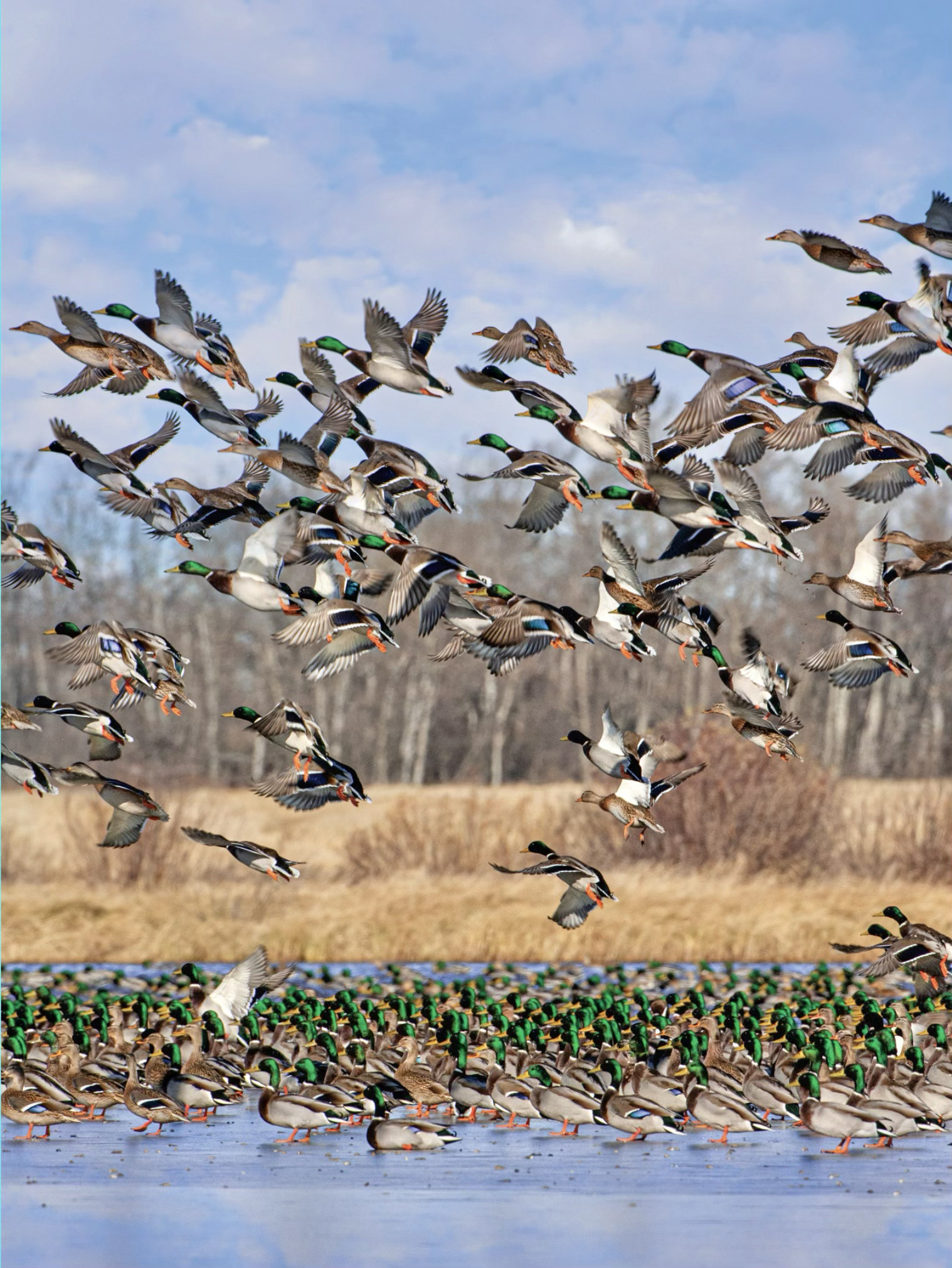
Photograph by Lee Thomas Kjo
While he’s less concerned about last season’s slog (he called it an “outlier” given the unseasonably warm weather), Kjos seriously questions the longer-term data put out by USFWS because it doesn’t match up with his observations in the field.
“I find it insulting that [agencies and some biologists] are telling me there’s nothing wrong,” says Kjos. “You’re telling me what I’ve seen in my life really didn’t happen? Well I’m not buying that. I feel gaslit. I tell people, ‘Show me, take me to the ducks. I’ll take you to where they used to be.’”
Kjos is troubled by the rise of outfitting and freelance-hunting pressure in Canada, and also by early-season hunters shooting hen mallards, which are hard to differentiate from drakes in September up North. Duck numbers are sliding but season lengths and bag limits stay the same because agencies, he says, are prioritizing hunter opportunity over the resource. He can’t stand that social media has cultivated numbers-focused hunters who “grind it out” because “piles make smiles” and so do “18-bird rainouts.”
Brent Birch, a lifelong Arkansas hunter who also travels the country for duck season, says when mallards do make their way to his home state, the sex-ratio is skewed.
“We’re definitely seeing a drake-heavy population of ducks. You can see them in the air, in a field feeding, in the woods loafing. And not just like three to four drakes for every hen — it’s like five, six, seven drakes for every hen,” says Birch. “And that’s great, everyone wants to shoot a greenhead, but at the same time you need to have the realization that greenheads don’t lay eggs. Even on a bright sunny day, when you can tell clearly what things are, you’re just not seeing a volume of hens that makes you feel like things are going okay for them.”
As the host of the Standard Sportsman Podcast and the editor of Greenhead magazine, Birch hears from hunters all over the country.
“I think you’d find very few hunters who would be upset that, if in the current circumstances, we dropped the limit to say, three mallards. Drop the hen limit. Make some kind of adjustment,” says Birch. “We’re not having success afield, we’re not seeing numbers, so why aren’t we adjusting something? … Especially if you’re somebody who grew up during a period where [seasons and limits] did bounce all over the place … Not changing something makes hunters distrustful of the data. Most don’t understand how it’s all accumulated and extrapolated.”
What the Data Say
Although the USFWS released estimates for most duck and goose species in its 2024 waterfowl population report, the headline for the waterfowling community centered around mallards: greenhead numbers are up 8 percent from 2023 at 6.6 million total (give or take 300,000 ducks) and down 16 percent from their long-term average of 7.9 million.
USFWS biologists estimated the total duck population at 34 million birds (give or take 600,000 and excluding a handful of species like scoters, mergansers, and wood ducks). That’s up five percent from last year and just 4 percent below the long-term average. As always, that total includes a whole lot of variability for individual species. So pintails, for instance, are down 49 percent while greenwing teal are up a healthy 38 percent.
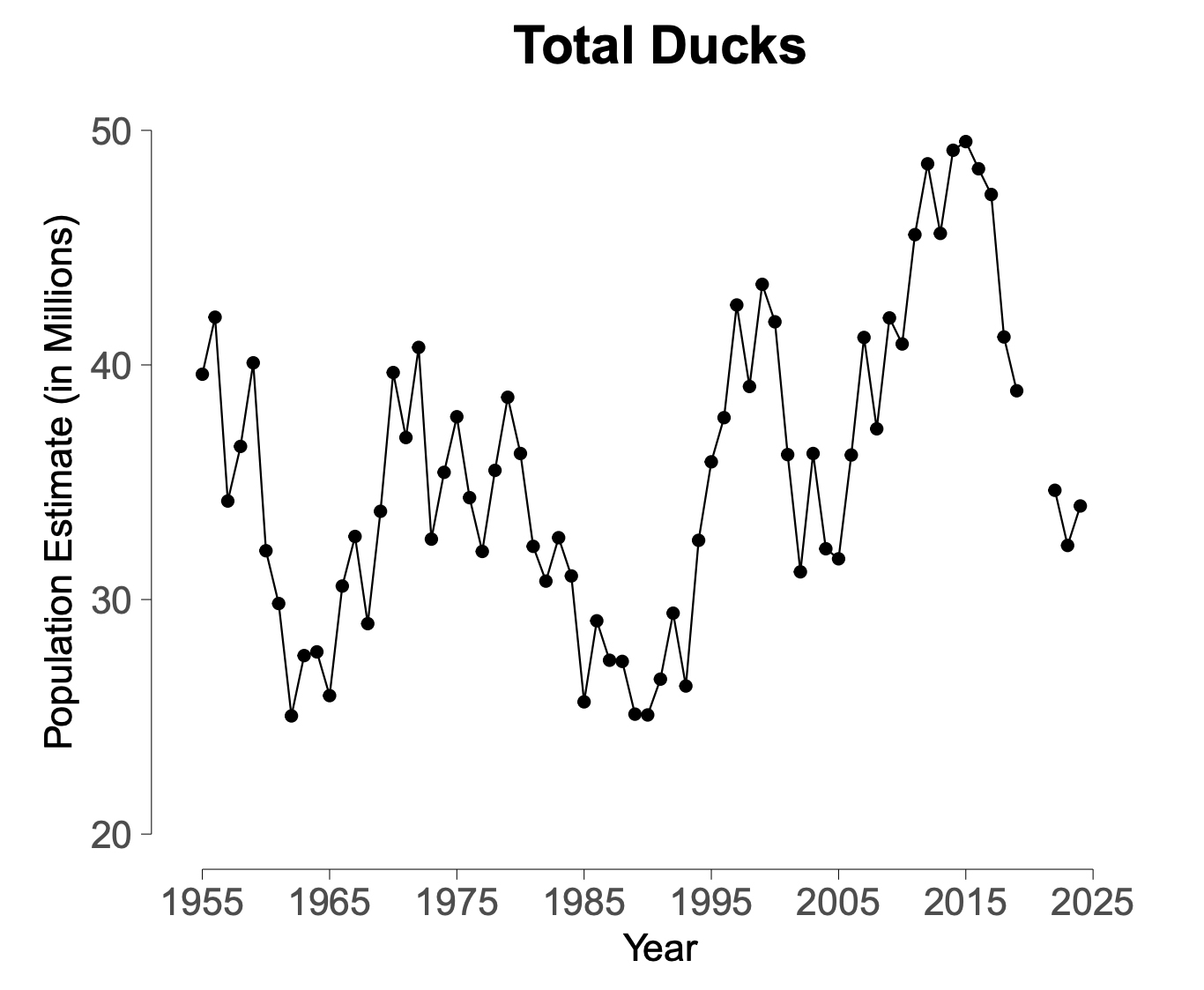
USFWS
Most of the biologists I spoke to don’t have beef with this population survey itself. It’s not a perfect reflection of the true number of ducks we have on the landscape, but it’s a good relative measure of those duck numbers over time. In other words, if biologists are counting ducks the same way for seven decades, that gives us a pretty good way to keep tabs on how well or poorly a species is faring.
“[This] is the best long-term survey of terrestrial vertebrates in the world,” says Thomas Riecke, an associate professor at the University of Montana who specializes in waterfowl conservation and population ecology. “It covers the entire core duck breeding area for the species it surveys … It’s a fabulous survey. It’s not perfect, but it’s the data we have.”
USFWS goose specialist and duck hunter Josh Dooley helped author this most recent report, and also participated in ground survey in the western Dakotas and eastern Montana.
“We’ve been doing [this survey] for a really long time, and we’re continuing to make improvements to it through time,” says Dooley, who mentioned incorporating technological advances when possible. “There’s a long history of doing these standardized aerial surveys so there’s nothing really hidden about what we’re doing.”

This year’s Migratory Bird Hunter Activity and Harvest report is the perfect example of what happens when USFWS doesn’t maintain exact continuity in its surveys. Last year’s report stated that some 815,000 duck hunters harvested 8.2 million ducks during the 2022-23 season. This year, officials changed how they administered the survey and reported that nearly 1.2 million duck hunters harvested 14.7 million ducks during the 2023-24 season.
USFWS includes a disclaimer in the report noting that these estimates are “very high,” and “may not be comparable” to previous harvest surveys without a full explanation of how the survey was changed. Even if you resist a mighty urge to compare those numbers, you can’t help but wonder: Which stat is closer to reality?
The USFWS branch chief of Monitoring and Data Management, Kathleen Fleming, declined to answer questions about these harvest estimate changes when reached by phone Tuesday. Instead, the USFWS responded with written answers to emailed questions.
“There has been no change to the way the U.S. Fish and Wildlife Service calculates harvest and active hunter estimates. This year, we had a higher number (and proportion) of hunters who reported hunting and harvesting birds than in the last several years … The Service also made it easier for hunters to choose to enter Season Totals rather than daily records, because of feedback from hunters in the past (especially avid hunters) that it was too difficult to enter all of their hunts day by day. This may have increased the number of avid hunters participating in the survey.”
That higher number could be due to changes in the online survey, like end-of-season reminders. The changes to the survey application, USFWS says, were designed to improve participation rates, data quality, and precision. A similar change to the data collection occurred when the USFWS switched from a mail survey in 1999 to HIP.
The Reason for the Conspiracies
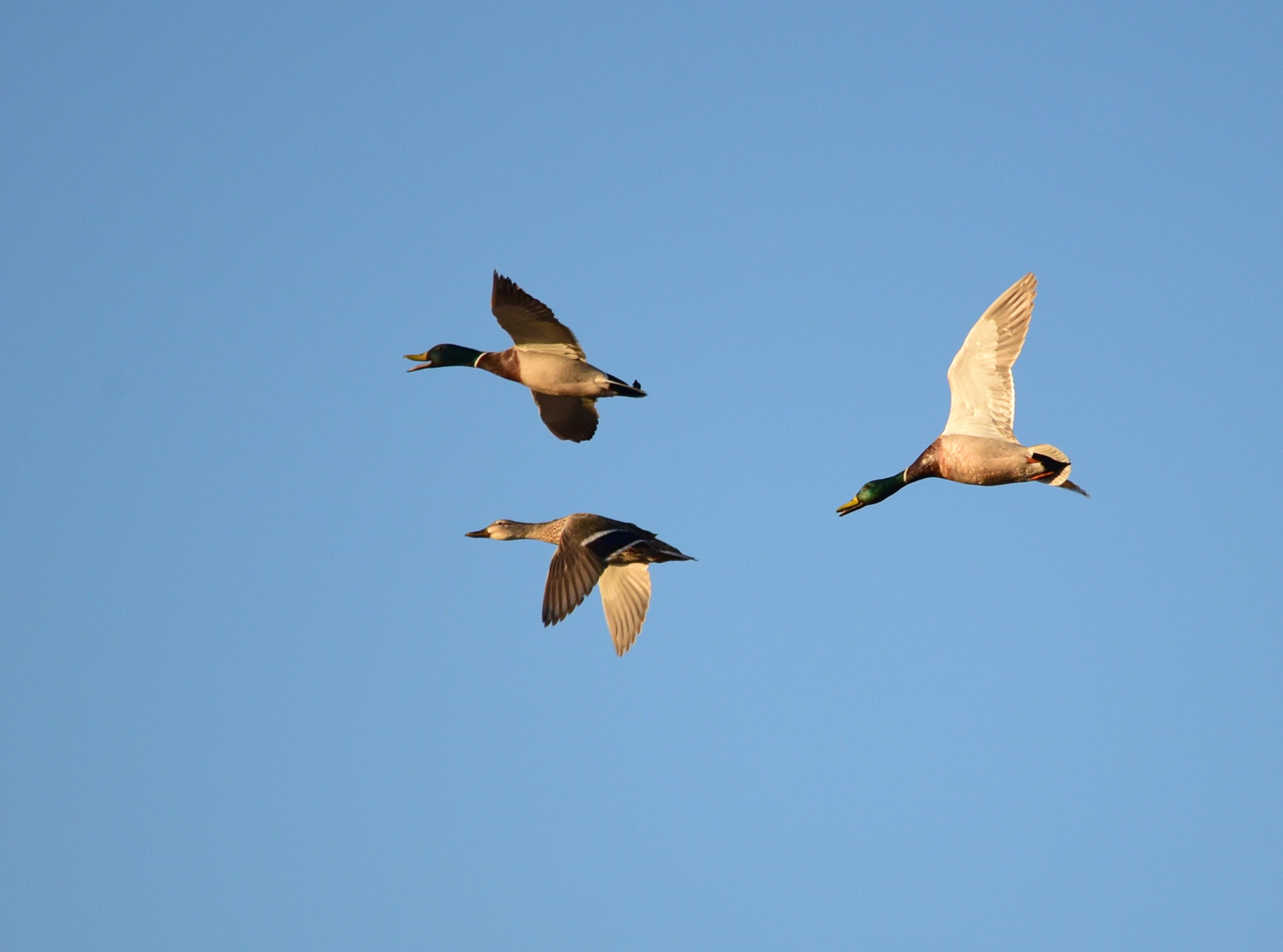
Photo by Tom Koerner / USFWS
There are several key reasons as to why hunters don’t trust USFWS data. Here’s a look at a couple of them.
Mallard Discrepancies
That rosy headline that mallards are up 8 percent from 2023? That’s a continental-wide number, not a flyway-specific stat. The 2024 counts for areas like southern Alberta, Manitoba, Saskatchewan show that breeding mallards are 42, 45, and 44 percent below their long term average, respectively.
“That’s catastrophic. And those are the birds that go to Arkansas,” says Chris Nicolai, a Delta Waterfowl biologist and North Dakota duck hunter who used to work for the USFWS. “So hunters are looking at the final summary that mallards went up eight percent but it’s like … look up the places where your ducks come from, and you’re correct. You’re 100 percent correct [that mallards are down for you].”
Meanwhile, mallard counts are between 22 and 39 percent above average in places like the Northwest Territories, British Columbia, and Yukon survey areas.
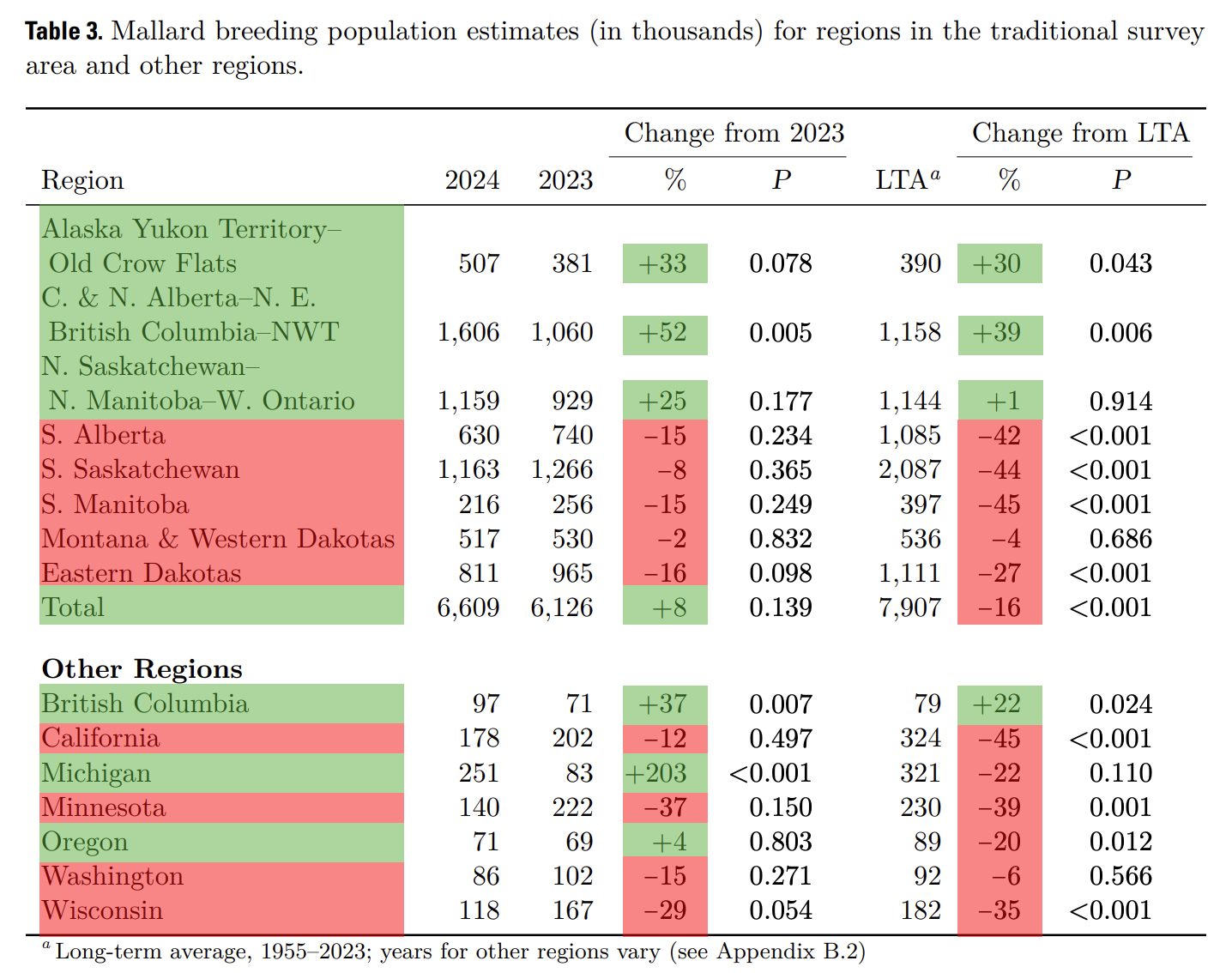
Chart via USFWS; color emphasis via Outdoor Life
“Those are not birds that go to Arkansas. Those are the birds that go to Idaho, Eastern Oregon, Eastern Washington. Those are places that shoot, in some years, more mallards than Arkansas,” says Nicolai. “Your birds [may have] tanked, but guess what? There are some good places to duck hunt right now and it’s not the same blind you’ve climbed in for 40 years.”
Understanding the Three-Pintail Bag Limit
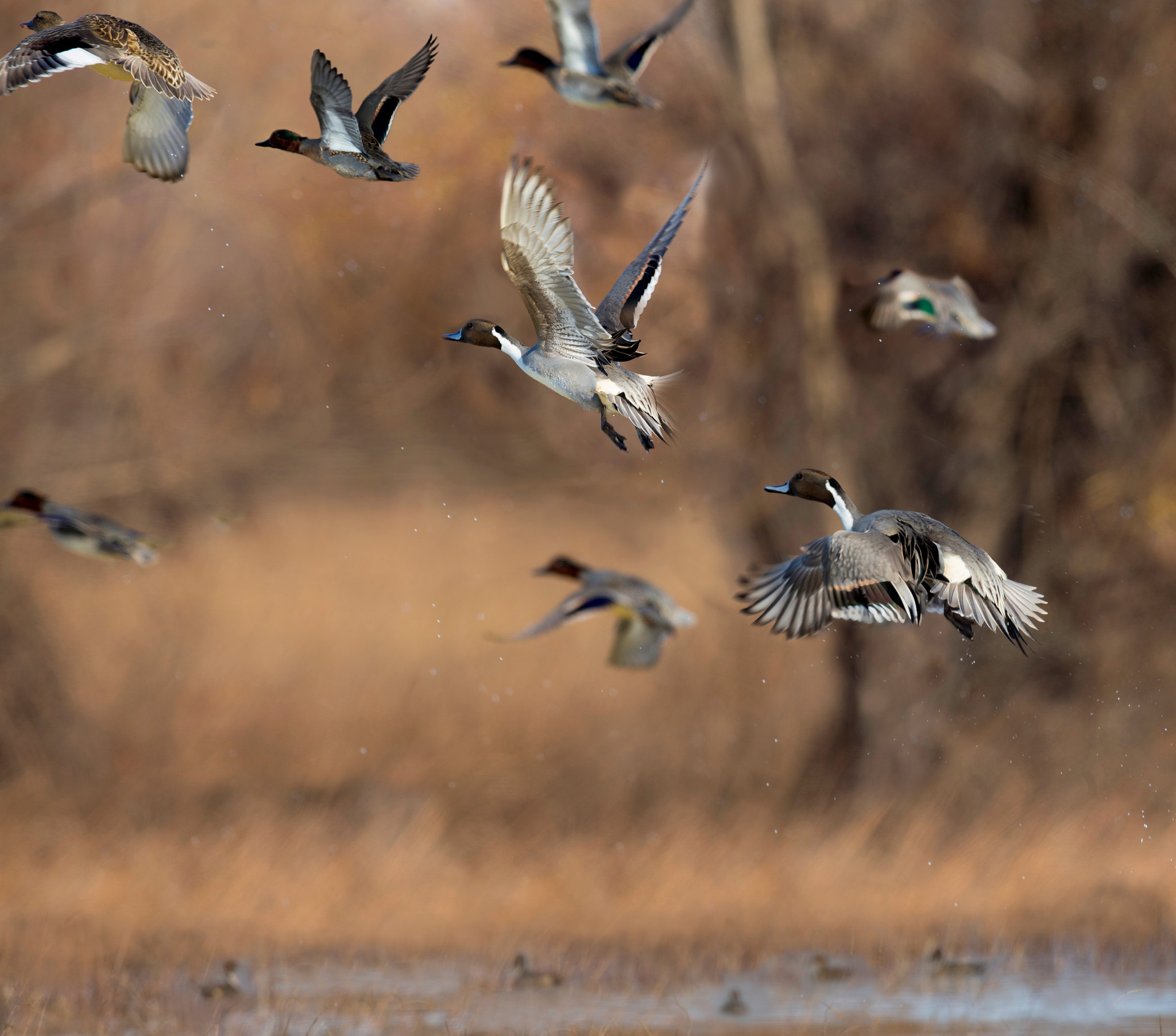
Photo by Steve N. Wilson / USFWS
One major issue that’s getting lost in translation between USFWS officials and hunters is the recommendation to expand pintail limits from one bird to three in 2025.
“The new pintail regulations on the surface don’t make sense to anyone who hunts,” says Birch. “They’re like, ‘So you’re telling me pintails are down on the long-term average 50 percent, but now we kill more?’ The regular everyday duck hunter [is] just looking for the high-level data, and the high-level data says the population is in half and we’re going to triple the limit.”
For decades Nicolai and other researchers have been “stirring the pot” by arguing that the USFWS overestimates pintail harvest. Finally, at one of the flyway meetings in 2021, he says, a harvest management working group biologist announced his team had been revisiting the pintail data.
“They said, ‘Hey guys, we started using banding data and we’re actually estimating pintail harvest at 230 percent of what it is,’” says Nicolai, who was thrilled to see biologists revisiting the status quo. “So they’ve been overestimating the pintail harvest by a factor of 2.3.”

Photo by Joseph Sands / USFWS
The USFWS has explained in detail why its new pintail management strategy is rooted in solid research. The short version, according to Nicolai, is that it manages for a harvest rate rather than a fixed bag limit.
“It’s pretty cool because if there are none, you’re still going to shoot none. If there are fewer ducks, there’s still some harvest opportunity. If there’s a shit-ton of ducks, there’s a lot of harvest opportunity,” says Nicolai. “It’s tracking the population better with banding data, and it’s as simple as that. Of any time we’ve changed the harvest regulation, this is the coolest one ever. We did do this [around] 2012 with canvasbacks. They made a new harvest strategy and it made opportunities to shoot two a day where the prior strategy would’ve had a closure. So this has happened before. We never get it right out of the gate. Everyone is learning, we’re using more data, listening to new ideas, and testing it. To me, this is a huge success.”
In other words, USFWS is signaling its willingness to change harvest strategies based on better intel, and to align with real-world duck hunting conditions. Because again: For many duck hunters who never shoot pintails, they’re still not going to shoot any pintails next fall, let alone three.
For the hunters who have the opportunity to shoot more than one sprig, that subsequent harvest and banding data will help USFWS biologists better understand — and manage — pintails. Plus their models show that additional pintail harvest by some hunters won’t negatively impact the population overall. There is some risk with the expansion and the regulations may need to be refined, says Nicolai, but it’s a calculated risk.
The Population Survey Tells Us a Lot, But Not Everything
Keep in mind that this annual survey is a breeding population survey. It’s conducted in the spring and early summer.
“The May surveys are so eagerly anticipated,” says Todd Arnold, a waterfowl biologist at the University of Minnesota. “But I think those numbers mean almost nothing in terms of ‘Is this going to be a successful year for duck hunters?’ What a successful year for duck hunters requires is really good production on the breeding grounds that produces a lot of stupid, naïve ducks that are going to decoy well and be harvestable … We don’t know what that looks like for the coming fall.”
Currently, there’s not a ton of great data about duck recruitment or survival rates on the prairie (biologists are working on it). And until we have those surveys, there’s no accurate prediction for what waterfowlers will see on opening day.
What Hunters Need to Know About Harvest and Duck Numbers
Here’s what hunters should keep in mind when their duck seasons open this year.
Hen Mallards Are in Trouble
What hunters are seeing in the field — fewer hen mallards — absolutely aligns with a growing body of research. The Prairie Pothole Region, researchers suspect, is incredibly dangerous for nesting hens in the summer.
“Harvest is a driver, but not the main driver, of duck populations. I think that’s a tough pill for people to swallow,” says Riecke. “The risk of a female dying from natural causes is almost 10 times greater than their risk of being shot by a hunter. That’s a massive misconception because people go out and shoot a bird and there’s a dead bird in their hand and they see everyone else shoot birds and they’re like ‘Oh man that’s a lot of hens.’ But there are still millions of female mallards out there. So it’s the easiest thing we can manage, hunting regulations, but it’s a common misconception that we can totally change this [sex ratio] with hunting.”
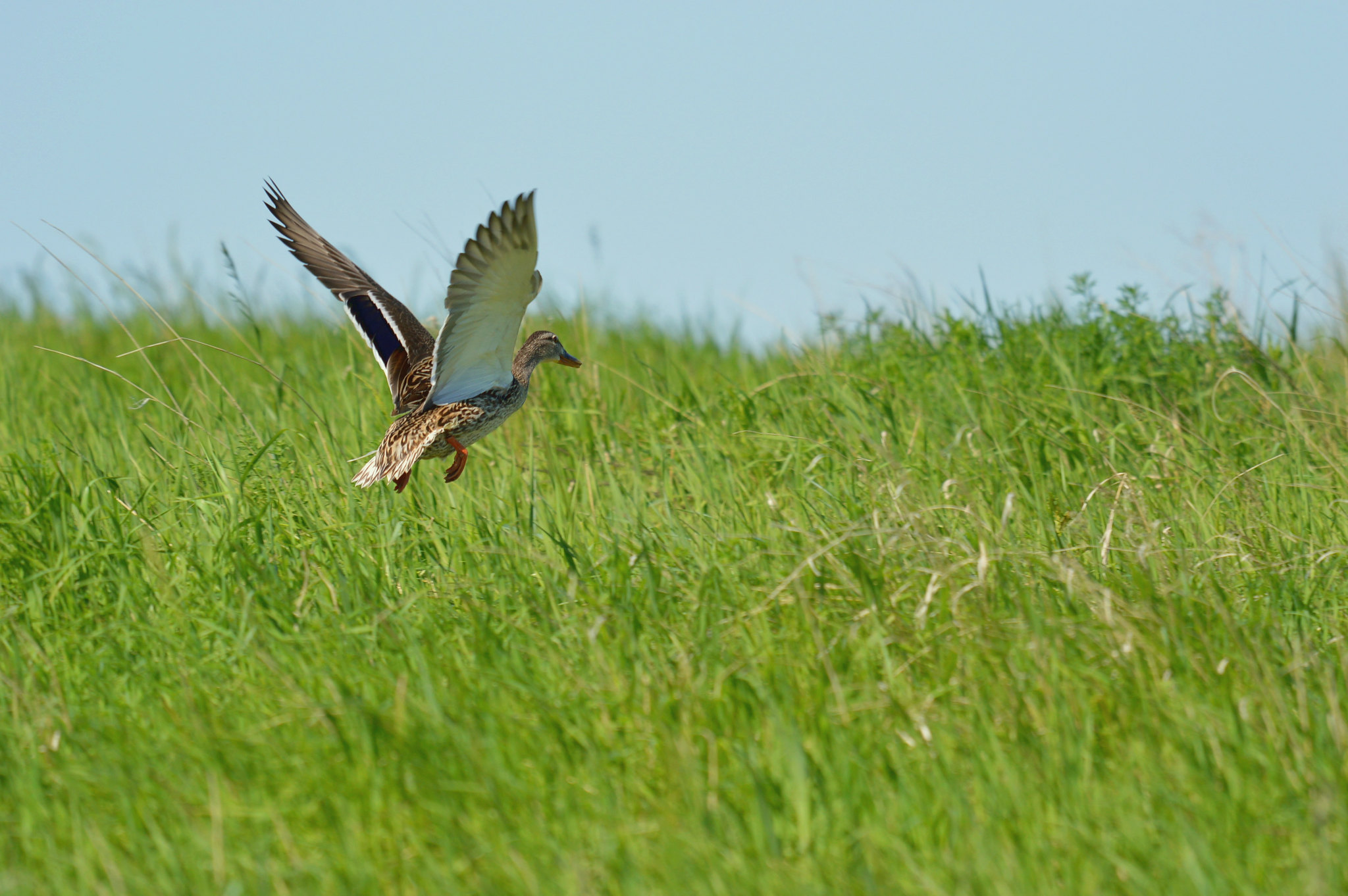
Photo by Ryan Moehring / USFWS
Of all the adult female mallards that are banded, says Riecke, just one in 20 is killed by hunters. However if there’s one place to really consider a hunter’s impact on hens, it’s in early hunting seasons. When the season opens in prairie Canada, all mallards are brown and it becomes nearly impossible to distinguish between hens and drakes. The same is true for early duck openers in northern states like North Dakota, Minnesota, and Wisconsin.
“I don’t think it’s feasible everywhere, but should we cut back to protect adult hens? It wouldn’t hurt, I’ll say that. But also it wouldn’t hurt to be harvesting more drakes to bring sex ratio back in line,” says Arnold, who has been studying the sex ratio problem. “What I will say about the harvest up North is that it’s predominantly young birds of the year. So even though they might harvest a lot of hens, they’re mostly going to be juvenile hens and those are less important [for reproduction]. As you move farther down the flyway, you hunt proportionally more adults. It’s the adult hens we care about in the population.”
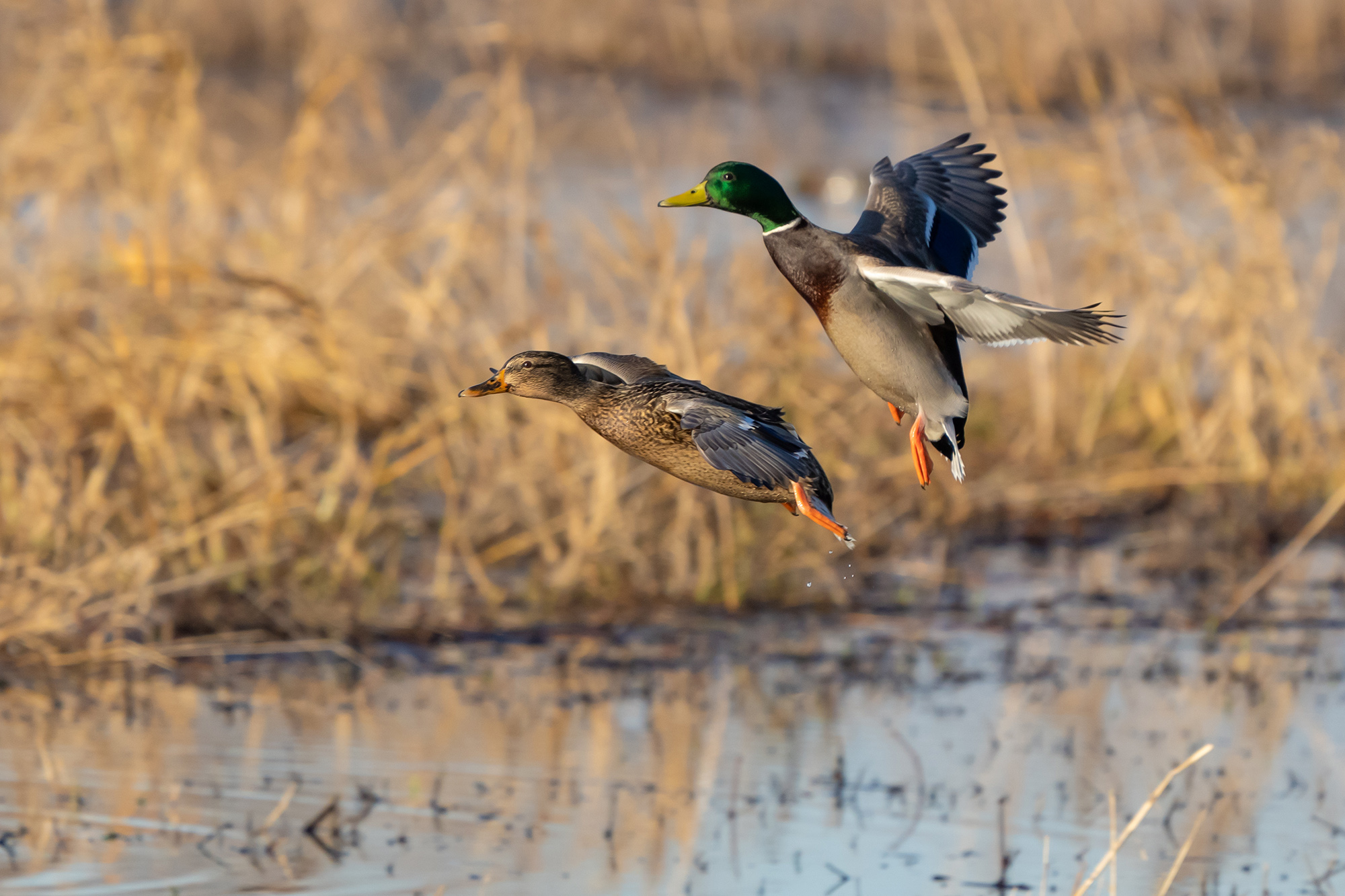
Photo by Jeff Huth / Adobe Stock
Meanwhile Douglas Osborne, a professor and waterfowl researcher at the University of Arkansas Monticello, is deeply concerned about the fate of hen mallards. He’s worried that regulations are not keeping pace with population declines.
“The policy makers continuously want science-based decisions. They want the science to support that something is happening. But listen, it takes us a couple years to get the data. So you not only have to live by the data, but you also gotta use your brain and common sense and say, ‘We are tanking sex ratios. The number of hens on the landscape is so low, let’s not shoot them,’” says Obsorne. “Don’t wait five years until a research project comes out to tell you the population of hens has tanked. Be proactive and say, ‘What does it hurt if we let a couple extra brown ones slide by?’ Make the decision [this year] that you’re all-in on fixing the hen mallard population.”
Hunting Pressure Has a Huge Impact on Duck Behavior

Photo by Natalie Krebs
Rather than focusing on duck populations Bradley Cohen, the associate professor of wildlife ecology at Tennessee Tech University and head of the Cohen Wildlife Lab, has been studying hunting pressure. He conducted a flyover study in Western Tennessee from 2019 to 2022 and found that waterfowlers are actually grinding.
“Hunting pressure is intense and it’s constant. There was no difference in people occupying blinds on a random Wednesday in December versus a Saturday a couple weeks later,” says Cohen, who is in favor of reevaluating splits. His lab’s data shows ducks need at least four days of a closed season to feel some relief from hunting pressure. “On any given day, about 75 to 90 percent of our huntable spots are hunted. Being a duck is a pretty risky proposition in the winter.”
Cohen and the other biologists I spoke to were clear: Hunters at the bottom of the flyways have a much harder time hunting ducks than Northern hunters do.
“This goes back to, ‘Are duck populations lower and does that affect our hunt quality?’ I’m not positive that the two are completely linked anymore,” says Cohen. “Does it matter that there’s 60 million ducks or 30 million ducks when all of them know what the game is because they’ve been so hunted? Sure, more ducks are better. We all want more ducks. But I’m not sure hunters would see a doubling in their success if they had a doubling in population size.”

Photo by Lee Thomas Kjos
This theory is supported, in part, by GPS and telemetry data.
“I hear all the conspiracies about ‘Where are all these ducks?’ The one thing we have learned from putting radios on ducks is that they are so good at finding refuges and avoiding hunters,” says Arnold, who feels for Southern hunters. “They just stockpile into National Wildlife Refuges. They go out at night to feed. It’s not that they don’t exist, but it’s that they know we’re out there and want to hunt them, and they’re really good at avoiding us.”
As hunters up North debate the appetite for delaying season start dates, hunters in the South are talking about ending them sooner.
“The season length is too long,” says Osborne, who worries about disrupting bonded pairs too late in the season for hens to find new mates. “They say the more days you can hunt, the more ducks that die. Populations are tanking, we gotta do something. I truly believe it’s time to go to a moderate 45-day hunting season. That 45-day structure would require the states to reset [regs] and then we’d probably close earlier in January. I do think those mid- to late-January hunts are probably negatively impacting populations.”
The USFWS Needs Hunters
Although the annual survey results used to help regulators set seasons for the same year, that changed after 2013. The main reason we’re now using, for instance, the 2024 data to set seasons in 2025 is because public comment periods have expanded to incorporate input from hunters.
“We can’t monitor these [waterfowl] populations without hunters,” says Josh Dooley, the USFWS goose specialist. “It’s the hunters who participate in harvest surveys [including our diary and envelope surveys]. That’s how we get our harvest estimates. They’re all coming from hunters. It’s the same thing on band recovery … We’re reliant on hunters to harvest birds and to report those bands.”
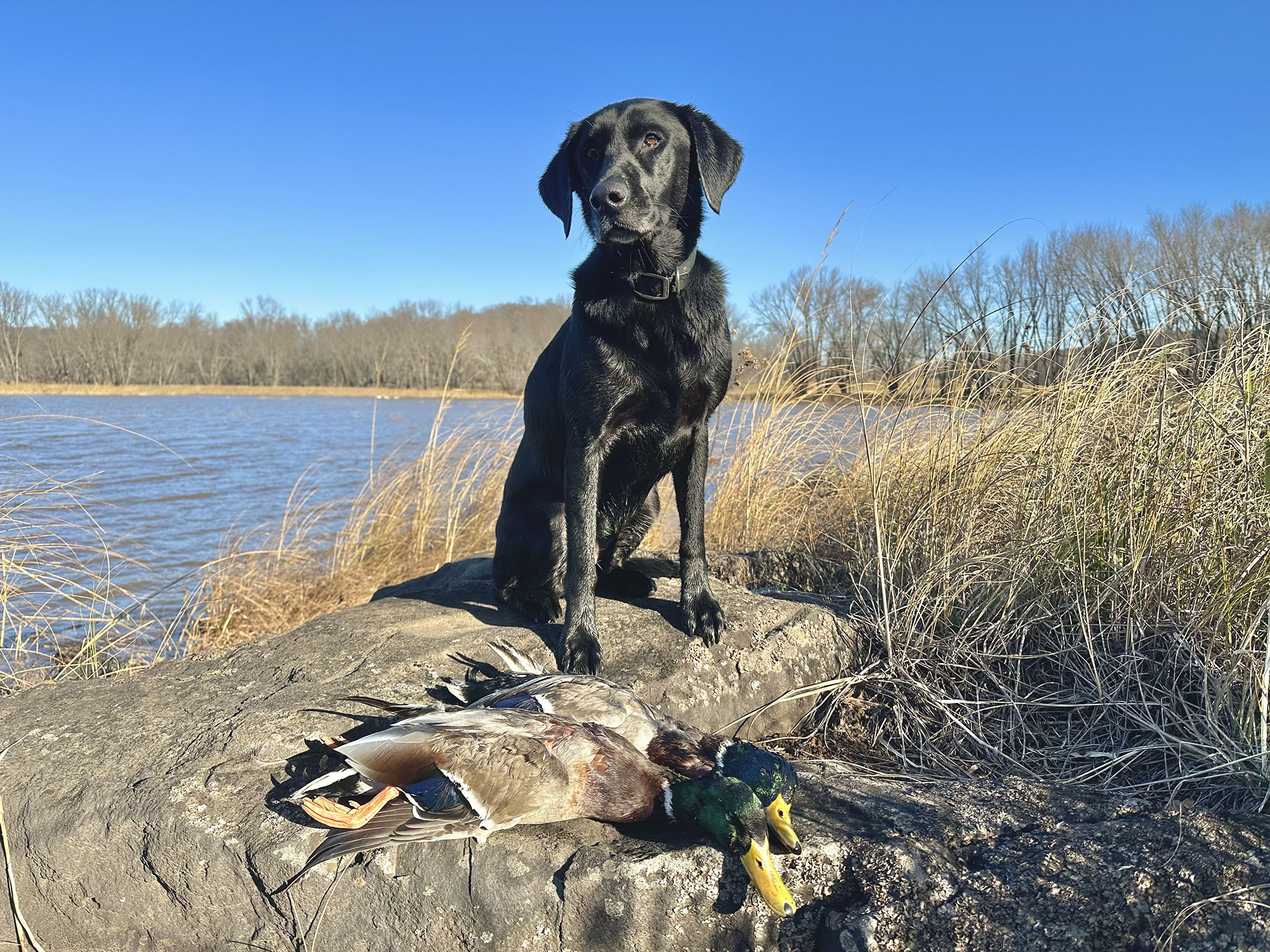
Photo by Alex Robins
As Kjos points out, if your state agency isn’t implementing the regulatory restrictions you want to see, police yourself. Some hunters are already doing this, like guys who never target Susies and even commercial operations like Pit Properties, a Minnesota goose outfit that sets self-imposed limits.
“What I would really like to see happen is a narrative shift in ethics where people start to take it upon themselves to not shoot whatever comes in. There’s a bunch of us out there,” says Kjos. “Let’s err on the side of the resource and let’s increase the hunting experience, not the opportunity.”
Nesting Habitat Is the Problem — and the Solution
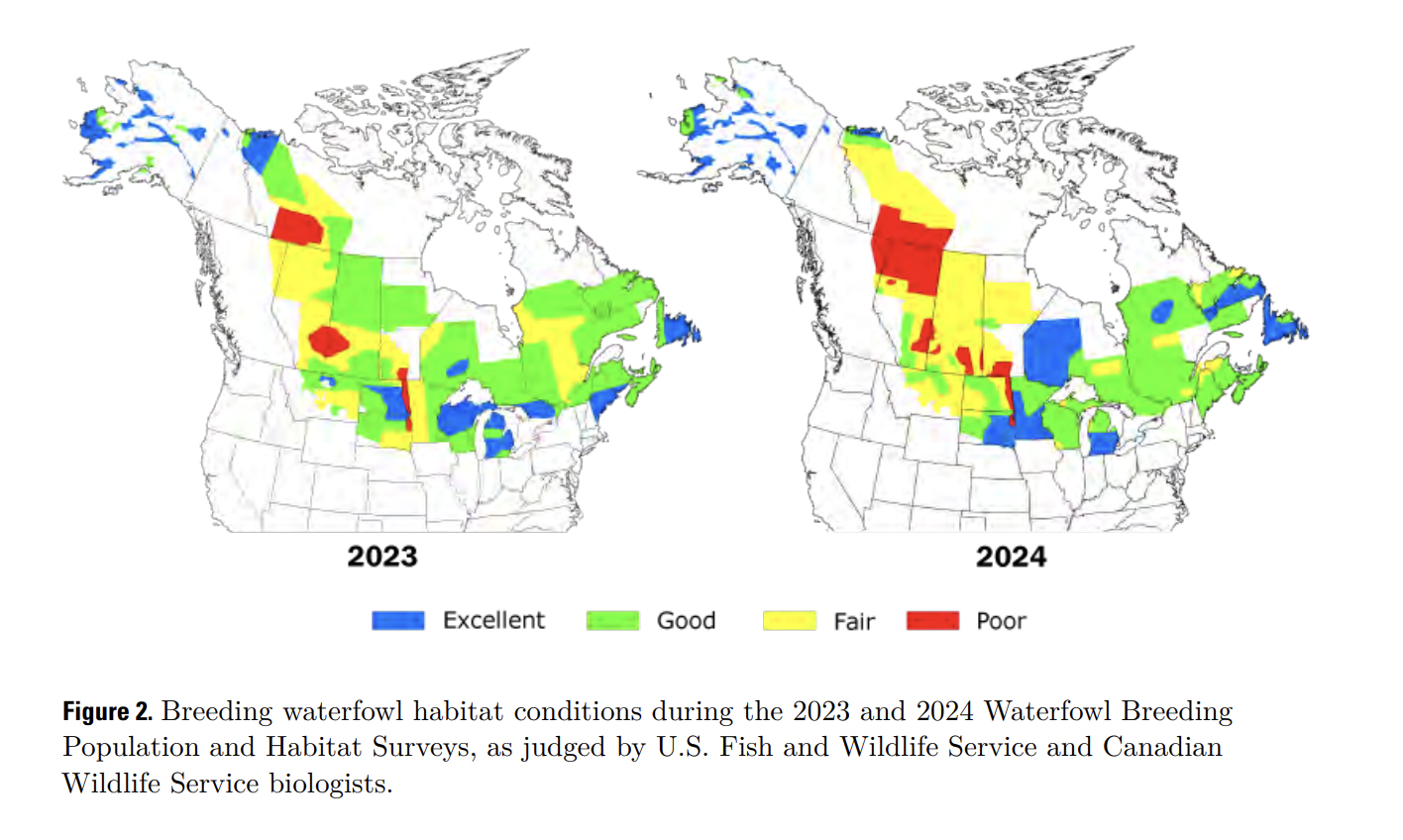
Illustration viaUSFWS
If you take away one thing from the annual duck survey, it’s that the Canadian prairie is in rough shape.
“We’re losing habitat on the breeding grounds at a huge rate and this is probably a huge driver” of declines in duck numbers and hens in particular, says Osborne. “The story is we’re losing habitat and our prairies are drier and drier up there each year. So it’s pushing the nesting ducks into smaller concentrated areas instead of having hens scattered all over the place. So potentially nest predators are more efficient at finding hens on the nest and killing more of them because they’re so much more concentrated now than they have been.”
While cyclical population boom and bust cycles aren’t unexpected, prolonged drought and modern agricultural practices that are contributing to a reduction in habitat means bad news for the long-haul.
“I think we’re in dire straits,” says Nicolai. “Things have been worse for sure. But we don’t have a lot more wiggle room to go. If we want to have a lot of ducks, we’ve got to start taking better care of our prairie habitat.”
The post Where Are All the Ducks? appeared first on Outdoor Life.
Source: https://www.outdoorlife.com/hunting/where-are-all-the-ducks/



